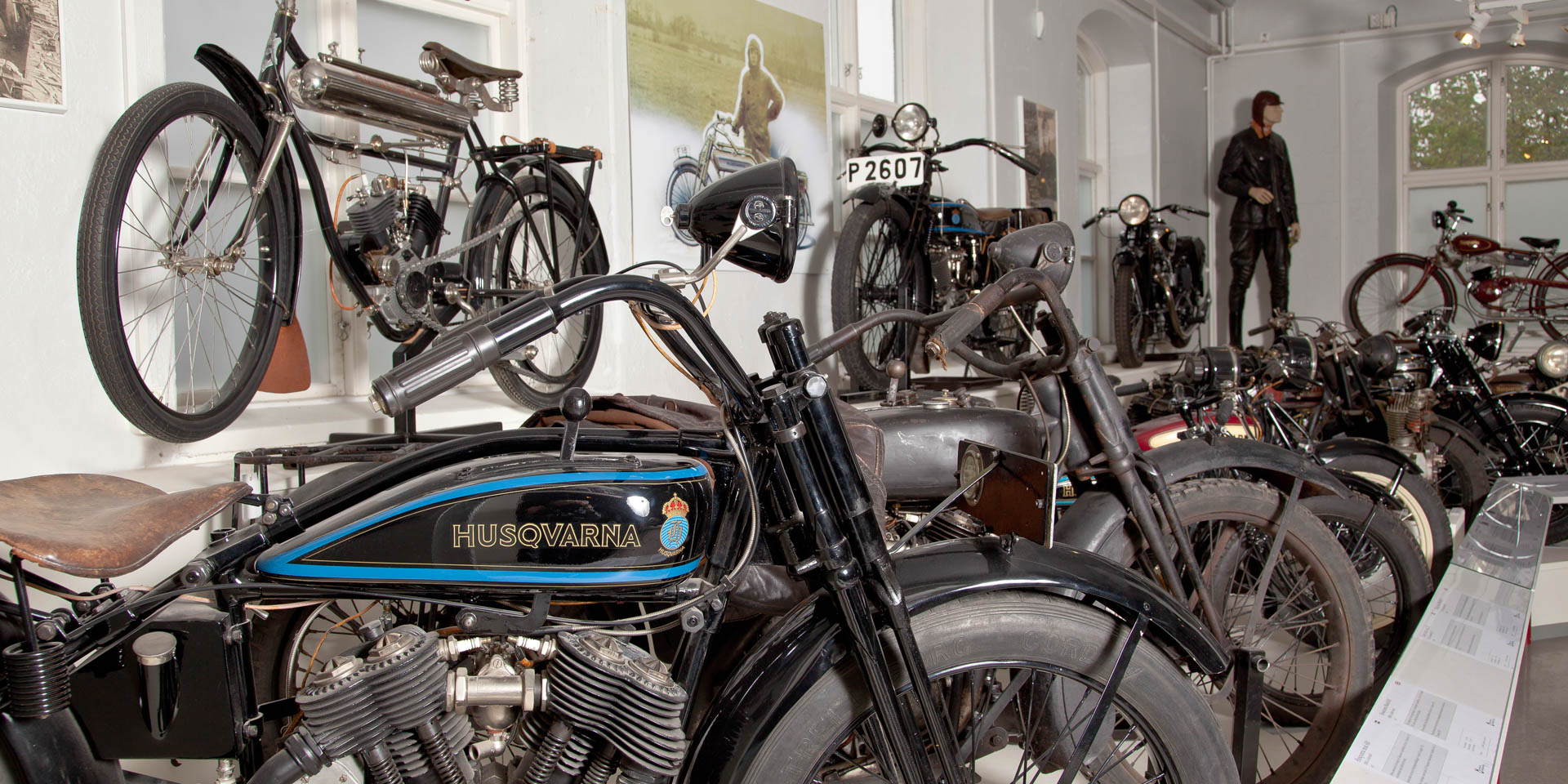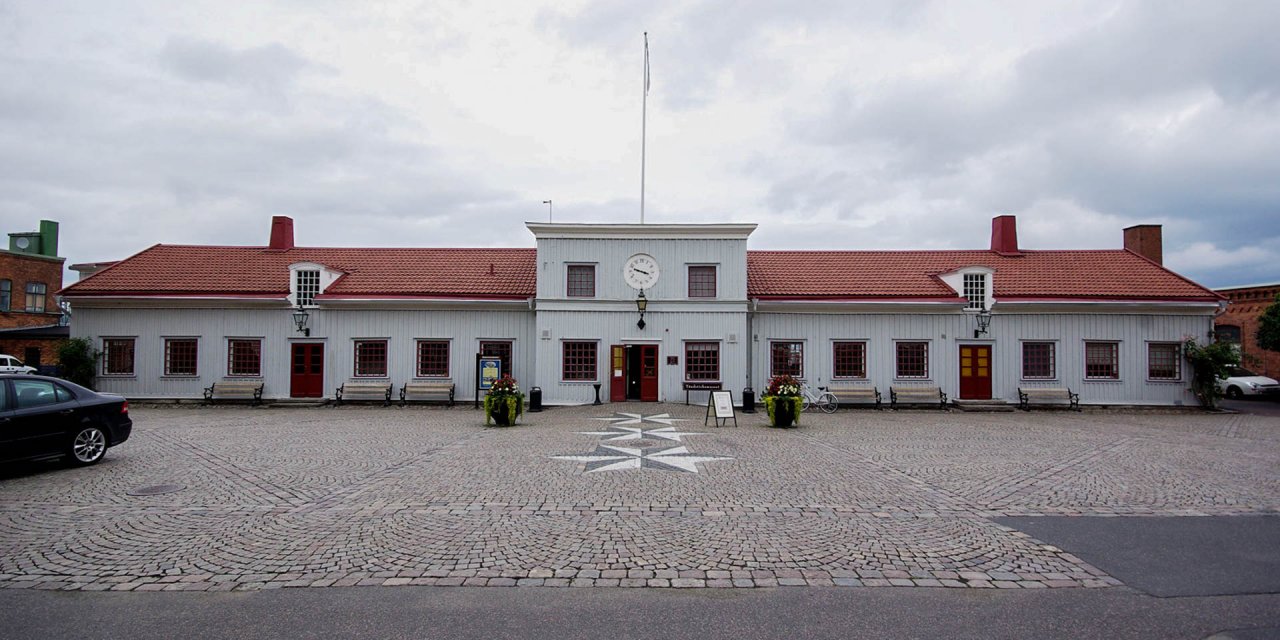

Husqvarna Museum
Factory museum in Jönköping
In Huskvarna, the eastern part of the city Jönköping in the centre of the municipality Jönköpings Kommun, the Husqvarna Museum presents the exciting company history of the Husqvarna brand, the bedrock of the Swedish metal industry.
From its foundation as the royal rifle factory in 1620 to today's premium manufacturer of forestry and gardening equipment, the Husqvarna Museum, with its 2,400 square metres of exhibition space and countless products, takes visitors through the individual epochs of the company's history, which has unusually often been marked by radical changes in the product range.
From rifle factory to own city district
Initially the gun factory was located in the centre of Jönköping. After a boring mill for the gun factory was built at the waterfall of the river Huskvarnaån in 1689, the factory moved to its present location. The factory settlement has developed into the initially independent town of Huskvarna, which became a district of Jönköping in the early 1970s.
1757 the royal rifle factory was privatized and renamed Husqvarna Gevärsfaktori (Husqvarna rifle factory). During this period the Smedbyn (Village of the Forge), which was only a few hundred meters away from the factory, was built in order to bring a large part of the production of individual parts closer to the factory, which until then had been scattered among home workers in the surrounding area. The Swedish Army's demand was limited to a few standardized types of small arms, so that the production of high quality hunting weapons was the main focus at that time. Around 200 different examples of the small arms produced in Huskvarna during the company's history are exhibited in a separate room in the museum.
Among them is a selection of military handguns produced throughout the company's history, the era of which ended in 1970 with the production of the last copies of the semi-automatic carbine Ak4 for the Swedish Army. Most of the exhibition consists of hunting weapons, the oldest of which is a masterfully crafted flintlock rifle from 1735 and the last rifle produced in 1989. The latter was produced in a limited edition of only 15 pieces as a so-called "jubilee rifle" for the company's 300th anniversary, which also marked the end of weapon production at Husqvarna.
In the end, only shotguns, mostly in luxury design, were produced and service work was carried out at the headquarters in Huskvarna. A small workshop with original tools shows a part of the gunsmith workshop, which was closed in 1990 with the retirement of the last gunsmith.
Craft becomes industry
After the rifle factory had received a large order for the Swedish military in 1867, the company was converted into a joint-stock company – Husqvarna Gefärsfaktori became Husqvarna Vappenfabrik Aktiebolaget (Husqvarna weapons factory). In order to transform the workshop into an industrial production facility, a new factory building was built at the same time – the building that now houses the Husqvarna Museum.
.A few years later the arms business declined. In search of a quick alternative, a second mainstay was built up from 1872 with the production of sewing machines, as the processing machines from the gun production were also suitable for the production of sewing machine parts with only minor adjustments. In 1874 the iron foundry, which had been built especially for this purpose, started the production of castings for the sewing machines.
In the Sewing Machines Department of the Husqvarna Museum you can explore the technical development of small textile machines in detail by means of numerous models. The first are the decorative foot-driven machines, painted in black and decorated with gold-coloured applications, on which our great-grandmothers sewed clothes for themselves and their family under the light of gas or petroleum lamps. Then the first electrically driven machines, followed by the first mechanical controls for various types of sewing, up to the digital all-rounders of the present day, where the complete study of the manual very likely takes longer than sewing a ball gown. Although Husqvarna stopped producing sewing machines several years ago, the machines are still produced and sold by the VSM Group under the well-known brand name Huskvarna Viking.
The exhibitions at Husqvarna Museum
The Husqvarna Museum shows in its interesting exhibitions the numerous examples from the different product groups that have been produced by today's Husqvarna AB during the company's history. In addition to the above-mentioned exhibitions of weapons and sewing machines, the premises of the former factory building also house exhibitions of outboard engines, bicycles, mopeds and, above all, motorcycles that were built with great success in Huskvarna from 1903 to 1986.
Followed by an exhibition of all kinds of household goods produced in Huskvarna over a period of about 100 years, ranging from simple cooking pots and pans to ice cream machines and electrically heated table pans. Among them is the well-known hand-operated meat grinder for the home kitchen, which has been a top seller and sold over 12 million units worldwide.
Another exhibition shows the foundry's product range, where, in addition to parts for the sewing machines, several hundred different items were cast, including copies of historical armour for decorative purposes, spittoons, flower bowls or cast-iron feet for coffins or beam scales for domestic use. Other products exhibited with reference to the foundry, which incidentally was the largest iron foundry in Northern Europe in the 1940s, are wood-burning stoves and kitchen stoves, the production of which began as early as the 1880s.
Then we see the further development of gas and electric cookers in Huskvarna and, as a logical continuation, the product range of the so-called white goods – electric cookers, refrigerators, dishwashers and washing machines, which were developed in Huskvarna until the 1970s and are still produced under the brand name Husqvarna by Electrolux.
Additional exhibitions are dedicated to the history of Husqvarna AB's current core business of forestry and gardening equipment, the beginnings of which date back to the 1950s. Here you can see the first petrol lawnmowers produced by Husqvarna in the 1950s, followed by the first chainsaws launched in the late 1950s and the brush cutters introduced in 1968. Also on display are several models of the garden tractors produced since 1986, including the first prototype from 1985. Finally, the exhibition of lawn mowing robots, which shows the technical development of the small independent garden helpers, whose world's first fully automatic model was launched by Husqvarna in 1995.
Further information about the museum
At the reception of the museum, besides the usual souvenirs, postcards and posters, you can buy a selection of books on the history of the Husqvarna Vappenfabrik and reprints of historical company catalogues. There you can also get a coffee or tea, soft drinks and ice cream.
The Husqvarna Museum is largely barrier-free. The aisles are wide enough for wheelchairs and prams. There is a disabled toilet on each floor and the two floors can be reached by a spacious elevator. There are also separate disabled parking spaces directly in front of the entrance area. Dogs are not allowed to enter the museum.
Husqvarna Museum: Opening hours & admission
Opening hours
Monday – Friday: 10:00 – 17:00
Admission
Last update: 06/2022 | Errors and omissions excepted.



